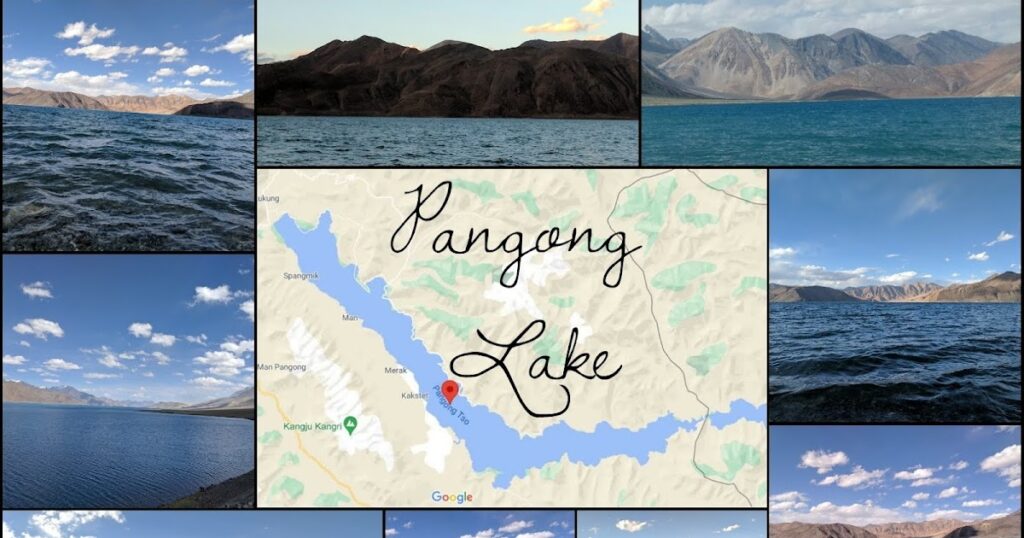Pangong
Tso, or Pangong Lake, situated at an elevation of about 4,300m (around
14,000ft), is the highest saltwater lake in the world. It is 134km long and
covers an area of over 600 square metres. Only 40% of the lake lies within
Ladakh. The rest is controlled by China. The lake is a picturesque sight, and
is one of the most popular destinations in Ladakh.
We set off
from Leh at 9 AM, eager to be on the road once again. Passing the 17th
century Chemrey monastery along the way, I realized just how little of Ladakh
we were actually seeing on this trip.
We crossed
the pass at Chang La (~17,000ft) and saw a different facet of Ladakh. The
mountains were the constant, but now rivers and sandy beds alternated every now
and then with muddy areas and lush green patches of vegetation.
Spots of
colour were added by wildflowers, yet another difference on this route.
We spotted
a number of yaks and horses grazing along the road, and were told that while
the yaks belonged to herders, the horses once belonged to the army, and were
now retired, and had been let out to pasture. The horses indeed seemed to have
gone wild, with long manes and unruly tails, happily grazing in the lush
greenery, barely lifting their head as cars whizzed by.
Somewhere
along the route, we entered the Changthang Wildlife sanctuary, home to, among
other animals, the Kiang (Tibetan wild ass) and the Himalayan Marmot. The
sanctuary is also home to a number of migratory birds. The sanctuary deserves a
trip by itself, and I made a mental note to remember this, if I ever managed to
visit Ladakh again!
The
wildflowers and pastures soon gave way to sand. At one place, sand was blowing
around in the wind, like a small dust storm. We hadn’t seen anything like this
even among the sand dunes of Nubra!
After such
a varied landscape, the Pangong lake was still a surprise, the beautiful shade
of blue peeking between the mountains.
The road
took us along the lake for quite a distance before we reached the campsite. It
was around 2 PM when we reached, and, we couldn’t wait to stow our luggage in
the tent and head towards the lake.
The
campsite stretched across the banks of the lake, and I shuddered to think of
the crowds that would gather. Thankfully, there weren’t too many people around
when we visited, and we were able to
enjoy our solitude.
It was like
staying on a beach camp, with more pebbles than sand! We spent most of our time
either walking along the water line, or sitting on one of the rocks with our
feet in the water. Small waves washed our feet, and even in summer, it was
cold! The water was cold, and the temperature was far lower than what we had
experienced through the entire trip. This was the only place my winter wear
felt inadequate.
Through the afternoon, we enjoyed the sight of the water, admiring the colours. As the sun began to set, we watched the light move across the mountains, and wondered what it would look like, from the other side of the lake, which is off-limits.
By
the time it got dark, I was cold and decided to head back to the tent for some
warmth, and to update my diary. Shankar stayed out far longer, and sometime
late in the night, was lucky enough to spot shooting stars! I haven’t yet
forgiven him for not waking me up!
We woke up
early in the morning to watch the sun rise. This was the one time I wished I
had a better camera, and better photography skills. Still, I managed as best as
I could… take a look at what it looked like…
We left
soon after breakfast to make our way back to Leh. We were leaving the next day
and had to settle our accounts.
We had
spent around 30 hours at Pangong, most of which was spent simply staring at the
lake and the mountains. Never before have I sat still for so long, simply
watching the water and the mountains with nothing to distract me – no birds, no
crustaceans, no people. Even today, the memories of that time are so strong. I
can simply close my eyes and be transported back there. I just find myself
wishing that could really happen, and that I could go back, and enjoy it all
over again!
On our way
back, we managed to spot the Himalayan Marmots – rodent-like creatures which
are endemic to the region. The animals have obviously learnt that tourists are
excellent sources of food, and turn up to beg for food.
We had
thought that this would be the end of the adventures on this trip, but how
wrong we were. We were about 40 km from Leh, passing by a monastery, when we
were hailed by an old man standing on the side of the road, asking for a lift.
By now, we had gotten used to this, and having a big car with the just the two
of us travelling, we had offered lifts to many people, and had a lot of
interesting conversations too. Thus, we were happy to offer the old man a lift.
What a surprise it was to us, that he turned out to be a Padmashri awardee, for
his social work. Mr. Tashi Tundop had received the award back in 2014, and at 82
years of age, was still active. It was inspiring to meet someone like him,
working even at this age, for the improvement of the community.
































